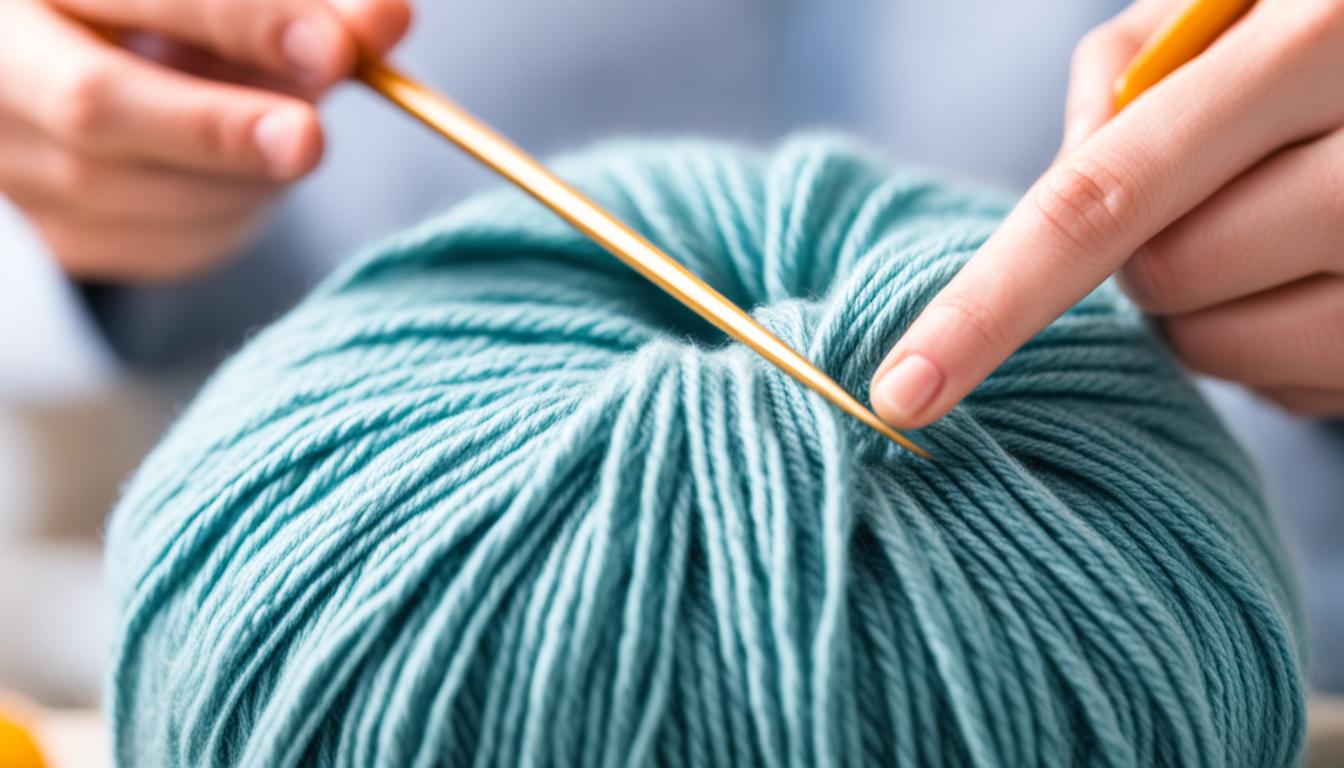Welcome to our beginner’s guide on how to knit! Knitting is a fascinating craft that allows you to create beautiful fabric by interlocking loops of yarn with needles. Whether you’re completely new to knitting or looking to improve your skills, this guide will provide you with the essential knowledge and techniques to get started.
Are you ready to embark on a knitting adventure? Let’s dive into the world of knitting for beginners and explore the techniques that will enable you to create your own unique projects.
Gathering Supplies for Knitting
Before diving into knitting, it’s important to gather the necessary supplies. This includes knitting needles and yarn. Beginners are advised to start with wooden or bamboo needles, as they provide a better grip on the yarn. As for the yarn, choosing a smooth, light-coloured yarn in a medium or bulky weight is recommended.
Having a pair of scissors, stitch markers, and a tapestry needle for weaving in ends are also essential knitting supplies. These tools will help you measure, mark, and finish your knitting projects with ease.
Additionally, beginners can benefit from knitting tutorials or instructional videos to learn the basics. Online platforms such as YouTube and Craftsy offer a wide range of knitting tutorials that cater to different skill levels. These tutorials provide step-by-step instructions and demonstrations, making it easier for beginners to grasp the fundamentals of knitting.

A Complete Table for Knitting Supplies:
| Supplies | Description |
|---|---|
| Knitting Needles | Wooden or bamboo needles for a better grip on the yarn. |
| Yarn | Smooth, light-coloured yarn in a medium or bulky weight. |
| Scissors | A pair of scissors for cutting yarn and finishing projects. |
| Stitch Markers | Markers to indicate specific points in your knitting. |
| Tapestry Needle | A needle for weaving in loose ends and finishing details. |
With these essential knitting supplies and the right tutorials, you’ll be well-equipped to start your knitting journey!
Learning the Basics of Knitting
Learning the basics of knitting is crucial for beginners to progress in their knitting journey. By mastering key techniques, such as casting on, knit stitch, purl stitch, and understanding knitting patterns, beginners can lay a solid foundation for their knitting skills.
Casting On
The first step in knitting is mastering the cast-on technique. This technique involves creating a slip knot and placing it on the needle. It forms the foundation row of stitches and allows you to start your knitting project.
Knit Stitch
The knit stitch is the most fundamental stitch in knitting. It creates a loop of yarn that interlocks with the loops in the previous row, forming the fabric. To knit, insert the needle into the loop on the left needle, wrap the yarn around the right needle, and pull the loop through. Repeat this process for each stitch across the row.
Purl Stitch
The purl stitch is another essential stitch to learn. It complements the knit stitch and creates a bumpy texture on the fabric. To purl, insert the needle into the loop on the left needle from right to left, wrap the yarn around the right needle counterclockwise, and pull the loop through. Repeat this process for each stitch across the row.
Knitting Patterns
Understanding how to read knitting patterns is vital for creating various projects. Knitting patterns provide instructions on the specific stitches and techniques required to create a particular item. They often include abbreviations and symbols that indicate different stitches or actions. By following knitting patterns, beginners can create a wide range of projects like scarves, hats, and blankets.

Now that you have mastered the basics of knitting, you are ready to explore a world of creative possibilities. Practice your cast on, knit stitch, purl stitch, and start experimenting with different knitting patterns to create beautiful handmade items.
How to Knit Easily?
Once beginners have mastered the basics of knitting, they can start progressing in their knitting skills. This involves taking on more challenging projects and learning advanced knitting stitches. Knitting patterns can provide inspiration and guidance for different projects, such as scarves, hats, and blankets. By exploring different patterns and techniques, beginners can continue to improve their knitting skills and expand their knowledge of knitting.
Advanced Knitting Stitches
Learning advanced knitting stitches allows beginners to add intricate details and unique textures to their projects. These stitches can elevate the overall look and feel of the finished piece. Here are a few examples of advanced knitting stitches:
- Cables: Cables create twists and texture in knitted fabric. They involve crossing stitches over each other to create beautiful cable patterns.
- Lace: Lace stitches form delicate and decorative patterns that add elegance to shawls, socks, and other lightweight projects.
- Fair Isle: Fair Isle, also known as stranded knitting, is a technique that creates intricate colorwork designs by carrying two colors of yarn across a row.
- Intarsia: Intarsia allows knitters to incorporate large areas of color or shape into their projects by using separate sections of different colored yarn.
Mastering these advanced knitting stitches opens up a world of possibilities to create unique and visually stunning pieces. By practicing these stitches, beginners can expand their repertoire and tackle more complex knitting projects.
Knitting Projects
When progressing in knitting, it’s essential to take on new knitting projects to challenge and enhance skills. Here are a few project ideas for those looking to advance their knitting:
- Fair Isle Hat: Create a colorful and patterned hat using the Fair Isle technique.
- Lace Shawl: Knit an intricate lace shawl that showcases delicate stitches and fine detail.
- Cable Sweater: Challenge yourself with a cable sweater that features intricate cable designs.
- Intarsia Blanket: Craft a cozy blanket with personalized intarsia designs using multiple colors.
Knitting these projects not only allows beginners to practice advanced stitches but also produces beautiful, functional items that can be cherished or gifted.
| Benefits of Progressing in Knitting |
|---|
| Allows for more creativity and personalization |
| Enhances problem-solving skills |
| Boosts confidence and sense of accomplishment |
| Expands knitting knowledge and skills |
Progressing in knitting not only results in beautiful projects but also brings numerous benefits. As knitters tackle more advanced patterns and stitches, they have the opportunity to unleash their creativity, personalize their projects, and showcase their skills. This process enhances problem-solving abilities as knitters navigate complex instructions and overcome challenges. Each completed project brings a sense of pride and accomplishment, boosting confidence in their knitting abilities. Moreover, progressing in knitting expands knowledge and skills, making the entire journey a continuous learning experience.

Benefits of Knitting
Knitting is more than just a craft for creating beautiful handmade items – it offers a wide range of benefits for mental wellbeing and overall health. Engaging in knitting can provide a sense of relaxation and stress relief, which is particularly beneficial in today’s fast-paced world. The rhythmic and repetitive motions of knitting can have a calming effect on the mind, helping to reduce anxiety and promote a sense of well-being.
Furthermore, knitting is a creative outlet that can enhance your imagination and foster a sense of self-expression. By choosing different yarn colors, textures, and patterns, you can create unique pieces that reflect your personal style and personality. This creative process can stimulate the brain and boost cognitive function, improving focus, concentration, and problem-solving skills.
Studies have shown that engaging in knitting and other crafts can also have long-term cognitive benefits. Regularly using your hands and practicing fine motor skills through knitting can help maintain dexterity and coordination as you age. Additionally, knitting and other craft activities have been found to reduce the risk of memory loss and cognitive decline.

The Therapeutic Benefits of Knitting
Knitting can be a therapeutic activity that promotes mental and emotional well-being. The repetitive nature of knitting can induce a meditative state, similar to mindfulness or meditation practices, allowing you to focus on the present moment and cultivate a sense of calm and inner peace. This can be especially beneficial for individuals experiencing stress, depression, or other mental health challenges.
Furthermore, the sense of accomplishment and pride that comes from completing a knitting project can boost self-esteem and confidence. Whether it’s a cozy scarf, a warm blanket, or a unique garment, seeing the finished product of your hard work can increase feelings of satisfaction and fulfillment.
The Social Aspect of Knitting
Knitting is often a social activity that brings people together. Joining knitting circles or groups allows you to connect with like-minded individuals who share a common interest. This sense of community and support can provide a valuable source of companionship and friendship, contributing to overall happiness and well-being.
Knitting can also be a way to give back to the community. Many knitters participate in charity knitting projects, creating items such as blankets, hats, or scarves for those in need. This act of kindness not only benefits the recipients but also gives knitters a sense of purpose and fulfillment.
Summary
From promoting mental wellbeing and relaxation to enhancing creativity and fostering a sense of community, knitting offers a multitude of benefits. By incorporating knitting into your daily routine, you can experience the positive effects on both your physical and mental health.
Conclusion
Starting to knit may seem daunting for beginners, but with the right guidance and practice, it can become an enjoyable and fulfilling hobby. By gathering the necessary supplies, learning the basics, and exploring different techniques and projects, beginners can embark on a knitting journey filled with creativity and accomplishment.
When it comes to knitting supplies, it’s important to invest in quality tools. Choose knitting needles that feel comfortable in your hands, such as the popular brand KnitPro. For smooth and even stitches, opt for high-quality yarns like Debbie Bliss or Rowan. These supplies will make your knitting experience more enjoyable and help you achieve better results.
Learning knitting techniques is essential for expanding your skills. Start with the basics of casting on, knitting stitches, and casting off. Then, gradually explore advanced techniques like lace knitting or cable knitting. Online platforms like KnittingHelp.com offer a wealth of tutorials and videos that can guide you through various knitting techniques.
Knitting not only provides a creative outlet but also offers mental wellbeing benefits. Whether it’s the calming repetitive motion or the focus required to follow a pattern, knitting can be a source of relaxation and stress relief. So, grab your knitting needles and yarn, and start creating your own masterpieces today!
FAQs
What are the basic knitting techniques I need to learn?
The basic knitting techniques for beginners include casting on, knitting stitches, and casting off. Mastering these techniques will provide a strong foundation for your knitting projects.
How do I read knitting patterns?
Reading knitting patterns is an important skill to learn. It involves understanding abbreviations and symbols used in the pattern instructions, as well as following row-by-row instructions to create the desired project.
What can I knit as a beginner?
As a beginner, you can start with simple projects like scarves, hats, and blankets. These projects will allow you to practice basic knitting stitches and gradually build your skills.
What are the benefits of knitting?
Knitting offers numerous benefits for mental wellbeing, including relaxation, stress relief, enhanced creativity, improved focus, and concentration. It has also been shown to have cognitive benefits and reduce the risk of memory loss.
How do I start knitting?
To start knitting, gather the necessary supplies, learn the basic knitting techniques, and explore different patterns and projects. With practice and patience, knitting can become an enjoyable and fulfilling hobby.

